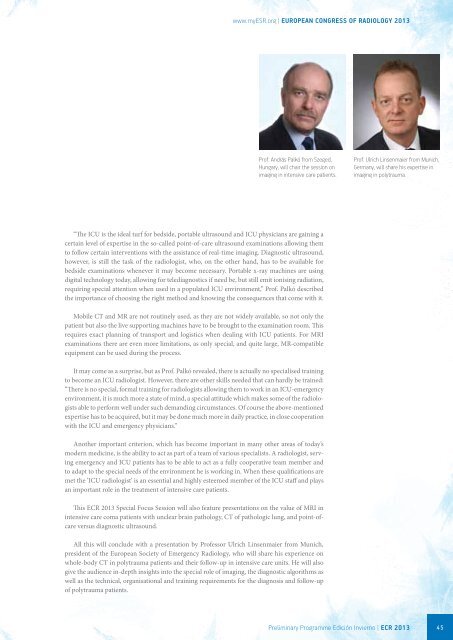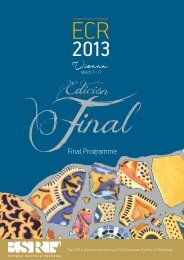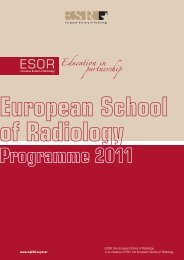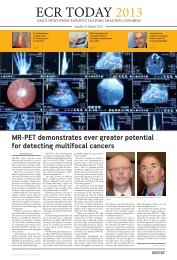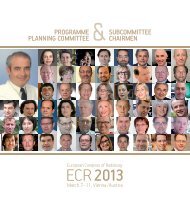New Horizons - myESR.org
New Horizons - myESR.org
New Horizons - myESR.org
- No tags were found...
Create successful ePaper yourself
Turn your PDF publications into a flip-book with our unique Google optimized e-Paper software.
www.<strong>myESR</strong>.<strong>org</strong> | EUROPEAN CONGRESS OF RADIOLOGY 2013Prof. András Palkó from Szeged,Hungary, will chair the session onimaging in intensive care patients.Prof. Ulrich Linsenmaier from Munich,Germany, will share his expertise inimaging in polytrauma.“The ICU is the ideal turf for bedside, portable ultrasound and ICU physicians are gaining acertain level of expertise in the so-called point-of-care ultrasound examinations allowing themto follow certain interventions with the assistance of real-time imaging. Diagnostic ultrasound,however, is still the task of the radiologist, who, on the other hand, has to be available forbedside examinations whenever it may become necessary. Portable x-ray machines are usingdigital technology today, allowing for telediagnostics if need be, but still emit ionising radiation,requiring special attention when used in a populated ICU environment,” Prof. Palkó describedthe importance of choosing the right method and knowing the consequences that come with it.Mobile CT and MR are not routinely used, as they are not widely available, so not only thepatient but also the live supporting machines have to be brought to the examination room. Thisrequires exact planning of transport and logistics when dealing with ICU patients. For MRIexaminations there are even more limitations, as only special, and quite large, MR-compatibleequipment can be used during the process.It may come as a surprise, but as Prof. Palkó revealed, there is actually no specialised trainingto become an ICU radiologist. However, there are other skills needed that can hardly be trained:“There is no special, formal training for radiologists allowing them to work in an ICU-emergencyenvironment, it is much more a state of mind, a special attitude which makes some of the radiologistsable to perform well under such demanding circumstances. Of course the above-mentionedexpertise has to be acquired, but it may be done much more in daily practice, in close cooperationwith the ICU and emergency physicians.”Another important criterion, which has become important in many other areas of today’smodern medicine, is the ability to act as part of a team of various specialists. A radiologist, servingemergency and ICU patients has to be able to act as a fully cooperative team member andto adapt to the special needs of the environment he is working in. When these qualifications aremet the ‘ICU radiologist’ is an essential and highly esteemed member of the ICU staff and playsan important role in the treatment of intensive care patients.This ECR 2013 Special Focus Session will also feature presentations on the value of MRI inintensive care coma patients with unclear brain pathology, CT of pathologic lung, and point-ofcareversus diagnostic ultrasound.All this will conclude with a presentation by Professor Ulrich Linsenmaier from Munich,president of the European Society of Emergency Radiology, who will share his experience onwhole-body CT in polytrauma patients and their follow-up in intensive care units. He will alsogive the audience in-depth insights into the special role of imaging, the diagnostic algorithms aswell as the technical, <strong>org</strong>anisational and training requirements for the diagnosis and follow-upof polytrauma patients.Preliminary Programme EdiciÓn Invierno | ECR 201345


